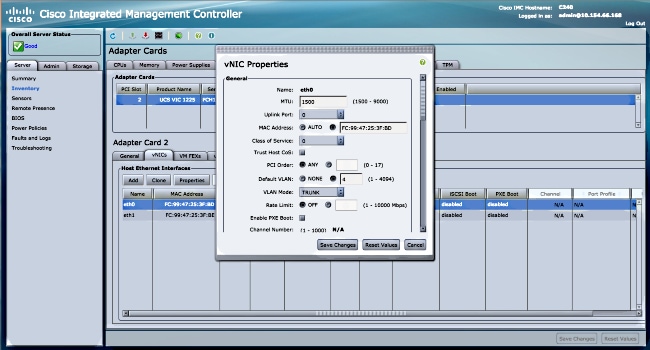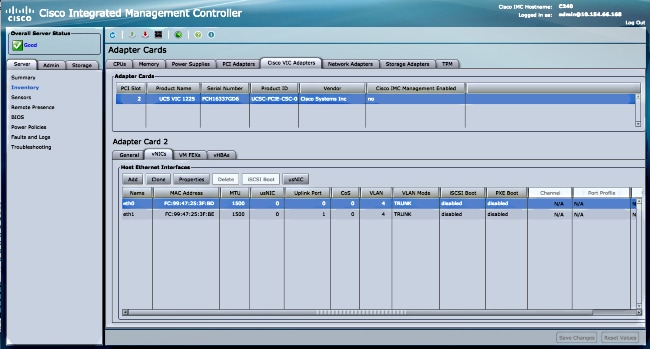Introduction
This document describes how to form a Link Aggregation Control Protocol (LACP) port-channel between the Nexus 9000 and the Unified Computing System (UCS) server.
Prerequisites
Requirements
There are no specific requirements for this document.
Components Used
The information in this document is based on these software and hardware versions:
- Nexus 9300 that runs Version 6.1(2)I(3)3a
- UCS C240 M3 Series Server that runs Cisco Integrated Management Controller (CIMC) Version 2.0(3f)
- Cisco Virtual Interface Card (VIC) Version 1225
- Red Hat Enterprise Linux Version 7.0
The information in this document was created from the devices in a specific lab environment. All of the devices used in this document started with a cleared (default) configuration. If your network is live, make sure that you understand the potential impact of any command.
Problem
The Nexus 9000 is not able to form LACP port-channels with the UCS server. If no lacp suspend-individual is configured on the port-channel, then it goes to I state. If it is not configured, then it suspends the port due to no LACP Data Unit (LACPDU).
The LACPDU interface counters on the Nexus 9000 show that transmitted (Tx) counters get incremented but received (Rx) counters are not incremented.
Here is how to configure an access port on Nexus 9000 and disable the LACP suspend-individual:
interface port-channel1019
switchport access vlan 4
no lacp suspend-individual
interface Ethernet1/19
description csm-b-ceph-001
switchport access vlan 4
spanning-tree port type edge
spanning-tree bpduguard enable
spanning-tree guard root
channel-group 1019 mode active
This can also be configured as a trunk-edge port; however, the behavior is not different:
Nexus9396X-2# show port-c sum
Flags: D - Down P - Up in port-channel (members)
I - Individual H - Hot-standby (LACP only)
s - Suspended r - Module-removed
S - Switched R - Routed
U - Up (port-channel)
M - Not in use. Min-links not met
--------------------------------------------------------------------------------
Group Port- Type Protocol Member Ports
Channel
--------------------------------------------------------------------------------
1019 Po1019(SD) Eth LACP Eth1/19(I) ----> Indicates No PDUs are being received
This can be (s) for suspended if the LACP suspend-individual is enabled (by default, it is enabled). However, the reason should be the same as why it does not receive Protocol Data Units (PDUs) from the peer.
Nexus9396X-2# show lacp interface e1/19
Interface Ethernet1/19 is individual
Channel group is 1019 port channel is Po1019
PDUs sent: 63
PDUs rcvd: 0 ----> Indicates No PDUs are being received from UCS server.
Markers sent: 0
Markers rcvd: 0
Marker response sent: 0
Marker response rcvd: 0
Unknown packets rcvd: 0
Illegal packets rcvd: 0
Lag Id: [ [(0, 0-0-0-0-0-0, 0, 0, 0), (0, 0-0-0-0-0-0, 0, 0, 0)] ]
Operational as aggregated link since Thu Jan 1 00:00:00 1970
Local Port: Eth1/19 MAC Address= 7c-69-f6-10-59-d7
System Identifier=0x8000, Port Identifier=0x8000,0x113
Operational key=33787
LACP_Activity=active
LACP_Timeout=Long Timeout (30s)
Synchronization=IN_SYNC
Collecting=true
Distributing=true
Partner information refresh timeout=Long Timeout (90s)
Actor Admin State=125
Actor Oper State=125
Neighbor: 0x0
MAC Address= 0-0-0-0-0-0
System Identifier=0x0, Port Identifier=0x0,0x0
Operational key=0
LACP_Activity=unknown
LACP_Timeout=Long Timeout (30s)
Synchronization=NOT_IN_SYNC
Collecting=false
Distributing=false
Partner Admin State=0
Partner Oper State=0
Aggregate or Individual(True=1)= 1
Ethanalyzer also does not capture PDUs that come from the peer device. However, a tcpdump that is taken from the server indicates that it sends as well as receives PDUs.
Solution
The lab setup showed that when the LACPDU was captured on the Nexus 9000, it was discovered that it sends LACPDU with the dot1q header as seen here:

However, the VLAN ID is set to 0. Now, when you look at the configuration for Virtual Network Interface Card (vNIC), you see that by default the VLAN is set to None and the VLAN Mode is set to access. Now even in this mode, it sends LACPDU with the dot1q header. However, the Nexus 9000 does not identify VLAN 0 and hence this packet is dropped. This behavior is documented in UCS C-Series Rack Servers VIC Connectivity Options.
In order to make this work, you must configure the VLAN Mode as Trunk and also configure the default VLAN as a VLAN that is allowed on that port. In order to change this, you log into your server's CIMC IP address.
- Click the Sever tab in the left pane and then click Inventory.
- Click Cisco VIC adapters in the right pane and then click vNICs.
- Choose the interface and then click Properties. You should be able to make the changes here:


- Once the changes are made, Save changes. You must reset the server for the changes to take effect. After the reset, the port-channel should form correctly.
In newer releases of Nexus 9000, Version 6.1(2)I(3)4 and 7.0(3)I1(1) and later, it ignores the dot1q header and packets reach Supervisor (SUP). This behavior is documented in Cisco bug ID CSCur69668.
Hence you should not encounter this issue in the newer releases.




 Feedback
Feedback